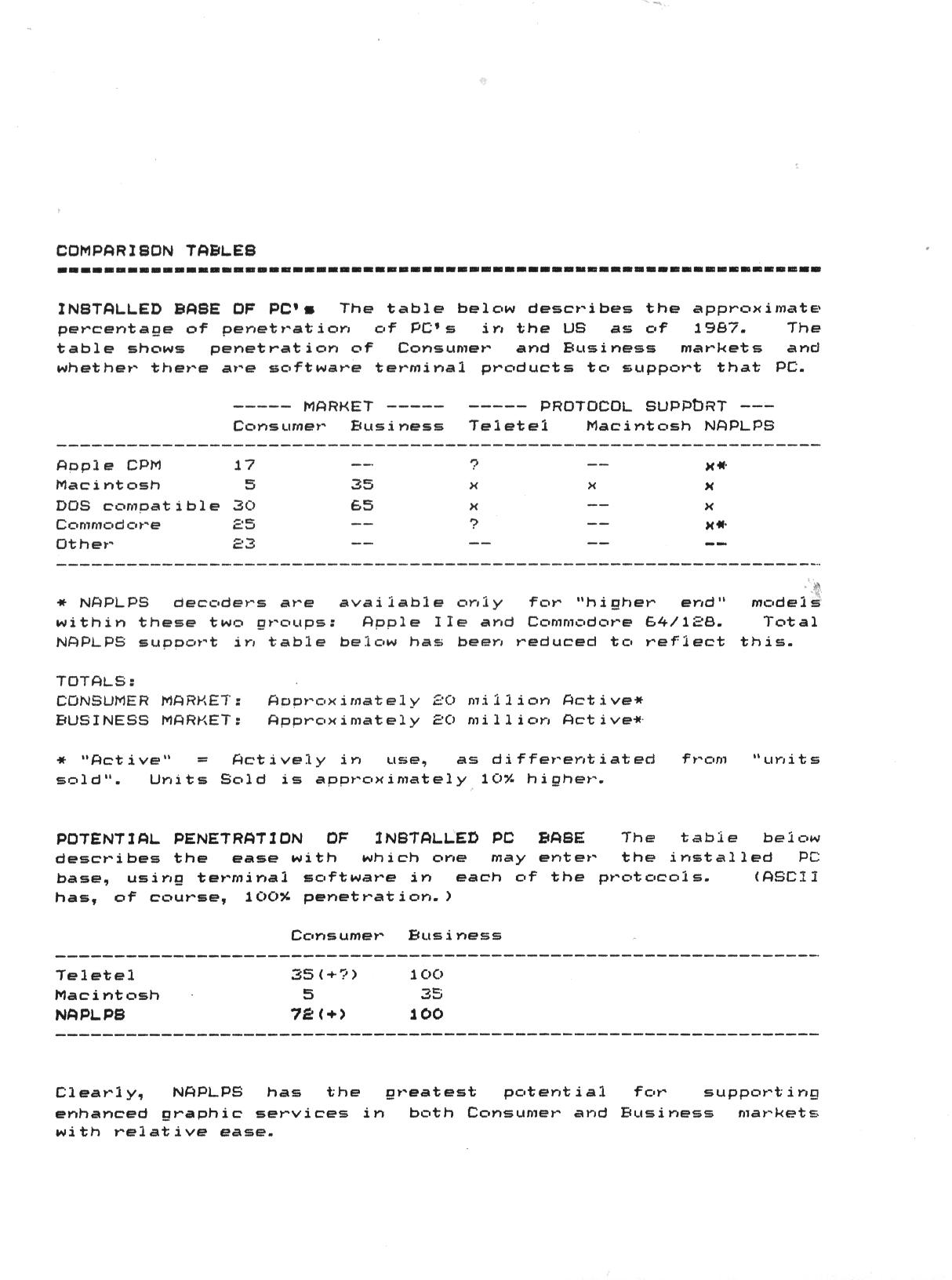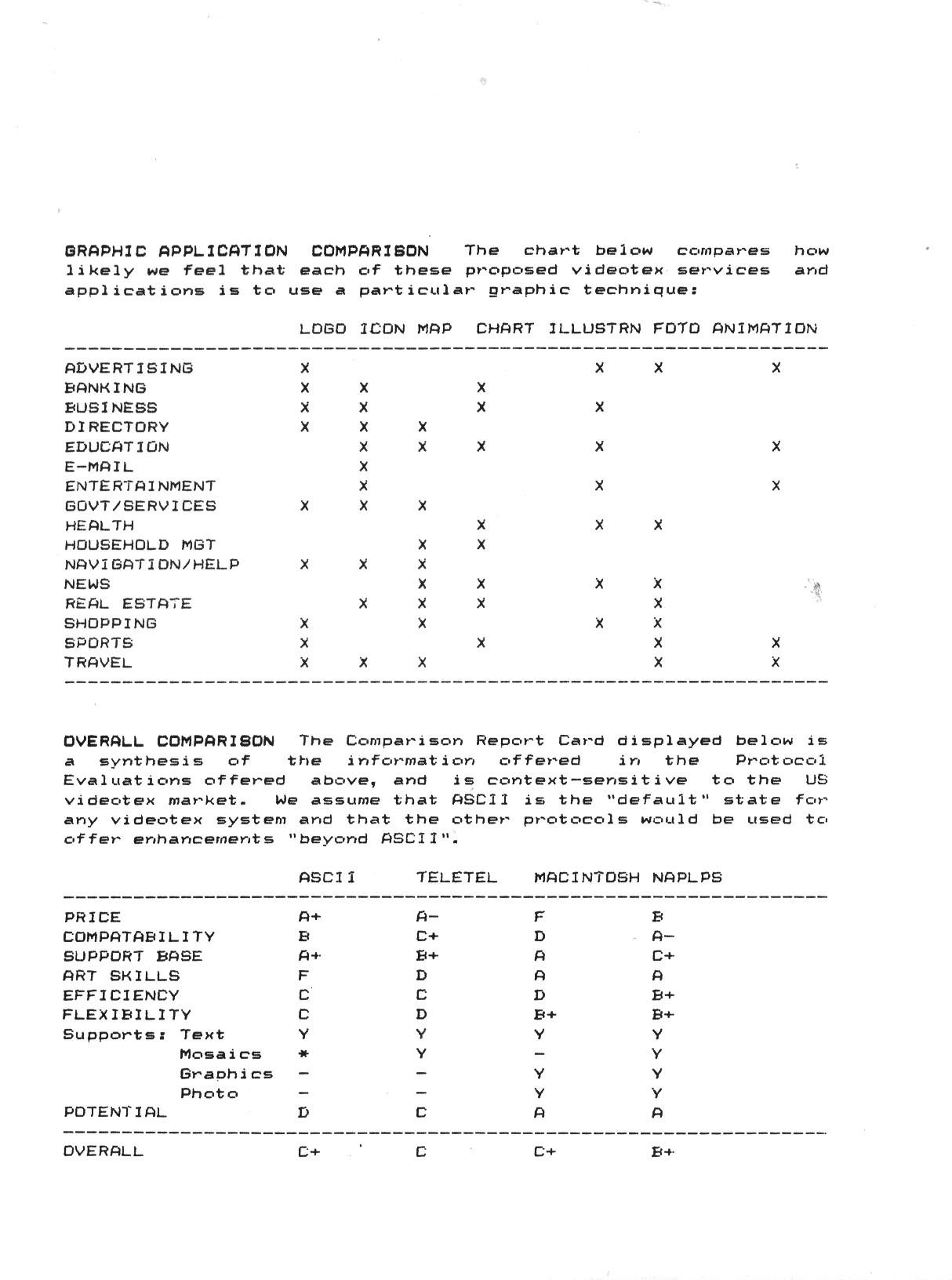Presentation Standards
Talking points for TCS Clients
The early days of interactive online were a battle among not only competing businesses, but competing technology platforms. TCS was one of the few companies that actually implemented interactive sites across the dominant presentation standards - and on an international scale. The the technical and marketing implications were significant.
The primary types of platforms at the time were:
- ASCII : plain text / no graphics, "global" standard
- Teletel / Prestel : Alphamosaic (simplistic character-based block graphics), national standards (France and Britain, respectively)
- Mactintosh : graphically sophisticated vectorgraphics, Black & White, product-specific (Apple)
- NAPLPS: graphically sophisticated vectorgraphic, national standards (US and Canada)
Note: Originally produced on a dot matrix printer. Classic.
Author: John Vaughan
Comparative Evaluation
We have tried to get a handle on the presentation protocols by describing their practical implications for each of the general areas listed below.
Achieving Critical Mass
SEAMLESSNESS
Ability to easily convert existing databases to/from other protocols, most of which are ASCII
ACCESSIBILITY
Implications for cost of entry to the IP and cost of decoder/service to user
UNIVERSALITY
Ability to serve a broad range of end-user terminal devices, specifically installed PC base
MARKET SUPPORT
Availability of existing services, support, and end-user terminals
Presentation / Design Issues
GRAPHIC SOPHISTICATION
Attractiveness, resolution, color; Can the system support advertising, logos, maps, navigation icons, photographic level imagery?
PRODUCTION SUPPORT
Availability and effectiveness of IP production and management utilities
EFFICIENCY
Conciseness of code; Implications for transmission, storage, and ultimate "cost" of graphic service in time & money
COMPREHENSIVENESS
Ability of protocol to adequately serve the full ranoe of anticipated IP and user needs
Extending the Market
SYNERGY BEYOND VIDEOTEX
Ability to take advantage of existing media and markets; both conventional & interactive
INTERNATIONAL MARKETS
Ability to serve foreign markets, especially those with non-Roman alphabets
UPGRADABILITY & EXTENSIBILITY
Developmental potentials Can it crow with the genera] advancement of technology?
PROTOCOL EVALUATION: ASCII
Achieving Critical Mass
SEAMLESSNESS Supports ASCII only
ACCESSIBILITY All hardware & software user terminal products support ASCII; free
UNIVERSALITY Totally ubiquitous ASCII is the functional "bottom line" for any microcomputer application involving text
Presentation / Design Issues
GRAPHIC SOPHISTICATION Functionally nil; Car, handle some layout enhancement, "blocky" graphics (none to speak of), extremely limited color, single font style; Text: 2 lines x 80 characters
PRODUCTION SUPPORT Awkward, block character-based BYTE EFFICIENCY Modest, considering low graphic capability COMPREHENSIVENESS Can handle only text-oriented applications; no icons or maps to speak of, limited animation, no photographic
Extending the Market
SYNERGY BEYOND VIDEOTEX Basic to all computer-based applications, but grenerally needs to be reprocessed (and enhanced) for use in presentation market
INTERNATIONAL MARKETS Character-based approach does not readily enter Asian or Mideast markets
UPGRADABILITY & EXTENSIBILITY A defined standard; extension is through reprocessing through another protocol
PROTOCOL EVALUATION: Teletel
Achieving Critical Mass
SEAMLESSNESS Supports ASCII & mosaic ("blocky") graphics
ACCESSIBILITY User terminals, both hardware (Minitel) & software (PC-based) are inexpensive and readily available
UNIVERSALITY Can display on a variety of microcomputer devices through use of a software decoder
MARKET SUPPORT Substantial support in terms of French-designed services and software; some question as to number & quality of American-based support
Presentation / Design Issues
GRAPHIC SOPHISTICATION Unimpressive: Minimal capabilities; marginally better than ASCII; Can handle some layout enhancement, "blocky" nraphics (none to speak of), extremely limited color, single font style; Text: 25 lines x 40 characters
PRODUCTION SUPPORT Awkward, block character-based BYTE EFFICIENCY Modest; negligible when compared to ASCII COMPREHENSIVENESS Can handle only text-oriented applications; no icons or maps to speak of, limited animation, no photographic
Extending the Market
SYNERGY BEYOND VIDEOTEX Limited to videotex; No ready transportability to video or print markets
INTERNATIONAL MARKETS Character-based approach does not readily enter Asian or Mideast markets
UPGRADABILITY & EXTENSIBILITY Limited, at best
PROTOCOL EVALUATION: Macintosh
Achieving Critical Mass
SEAMLESSNESS Supports ASCII and hi-res graphics (proprietary)
ACCESSIBILITY Very expensive - especially for color; No low-end user terminals at all, no software terminal emulation
UNIVERSALITY Nil; supports only Mac population; Minitel, DOS-compatibles, ever, Apple-CPM
excludes
MARKET SUPPORT Excellent software support among multiple vendors; hardware almost exclusively single-vendor (a minus)
Presentation / Design Issues
GRAPHIC SOPHISTICATION Excellent; supports multiple font styles, hi-resolution graphics; though only most expensive units car, actually support color
PRODUCTION SUPPORT Excellent BYTE EFFICIENCY Poor COMPREHENSIVENESS Capable of broad range of applications, including maps, logos, icons, photographic, animations
Extending the Market
SYNERGY BEYOND VIDEOTEX Excellent support in print/publishing & CAD, growing support in video, extensive installed PC base
INTERNATIONAL MARKETS Capable of handling non-Roman languages, international marketing support open to question
UPGRADABILITY & EXTENSIBILITY Powerful potential within its own hardware family, supports a broad range of peripheral devices
PROTOCOL EVALUATION: NAPLPS
Achieving Critical Mass
SEAMLESSNESS Supports ASCII, Teletel-style Mosaic graphics and Hi-res graphics
ACCESSIBILITY Relatively inexpensive hardware (Minitel-like) and software terminals (for all major PC lines, including Macintosh)
UNIVERSALITY Can display graphics a. text on all machines and popular graphics cards used in installed base of microcomputers throuch use of software decoders
MARKET SUPPORT Hardware and software support from multiple vendors for broad range of applications; credibility as government-sanctioned protocol in US, Canada & Japan
Presentation / Design Issues
GRAPHIC SOPHISTICATION Excellent; supports multiple font styles, broad range of color, hi-resolution graphics
PRODUCTION SUPPORT Complete range of utilities available from
multiple vendors
BYTE EFFICIENCY Excellent for graphics, equivalent to ASCII for text
COMPREHENSIVENESS Capable of supporting a broad range of applications; including maps, icons, logos, photographic, animation
Extending the Market
SYNERGY BEYOND VIDEOTEX Existing applications in other markets "beyond videotex" include; print/publishing, video production, public kiosks, cable TV, slidemaking, electronic signage
INTERNATIONAL MARKETS Capable of non-Roman language characters, already supported in Japan, Internationally registered protocol
UPGRADABILITY & EXTENSIBILITY Powerful potential for a variety of devices; supports a broad range of peripheral devices
COMPARISON TABLES
OVERALL COMPARISON The Comparison Report Card displayed below is a synthesis of the information offered in the Protocol Evaluations offered above, and is context-sensitive to the US videotex market. We assume that ASCII is the "default" state for any videotex system and that the other protocols would be used to offer enhancements "beyond ASCII".
Installed Base
INSTALLED BASE OF PC's The table below describes the approximate percentage of penetration of PC's in the US as of 1987. The table shows penetration of Consumer and Business markets and whether there are software terminal products to support that PC.

Comparison

EVALUATION WRAP-UP
ASCII
ASCII text is truly the "bottom line" of any videotex service; its ubiquity accounts for the high scores in PRICE and SUPPORT BASE. But the flip side of ASCII's low-end pervasiveness is that it does. not support Graphics per se or extended device control (both of which allow entry to the higher-end markets); thus it gets compromised ratings in all other categories.
Teletel
Teletel's main strengths reflect its installed SUPPORT BASE in France and the inexpensive PRICE of the Minitel terminal, both of which are a function of extensive large-scale government subsidation in a monopoly environment. On a practical present ationlservice design basis, TELETEL offers little to the service provider that cannot be accomplished about as well by using ASCII.
Macintosh
The Mactintosh gets high scores in ART SKILLS, SUPPORT BASE, FLEXIBILITY and POTENTIAL (for all the obvious reas•ns), but suffers in COMPATABILITY and EFFICIENCY for its failure to easily exchange graphic files with other computers or develop a concise format for file transmission. Although the MAC is obviously considered cost-effective as a standalone workstation, there is neither a low-cost, low-end hardware user terminal unit available nor inexpensive emulation software for non-Mac computers; hence the poor PRICE rating. It should be noted that MACINTOSH': substantial support base is due primarily to its strong niche role (standalone desktop publishing) in the microcomputer market.
NAPLPS
The North American Presentation Level Protocol Syntax is the most consistently "good" protocol across all categories. It has all of the advantages of high end graphical ART SKILLS, has the FLEXIBILITY and COMPATABILITY to support the low end protocols (like ASCII & Teletel), and yet remains uncompromised by the "proprietariness" and inefficient graphic communication design which restrict the MACINTOSH. The Minitel-like NAPLPS ALEX terminal combines the best of Teletel (low cost, simple-to-use visual communication device) with the best of the Mac (graphically sophisticated) and the best of ASCII (standardized display protocol, efficient transmission) and user terminal software is available for all of the most popular micrcomputers. The lower rating in the SUPPORT BASE category primarily reflects a relatively smaller installed base of NAPLPS videotex services at present (although there is substantial market support for the POTENTIAL applications of NAPLPS "beyond videotex"). We propose that the failure of previous US attempts at videotex was not a function of the NAPLPS protocol (most other non-NAPLPS videotex ventures in the US have failed, as well), and that it still remains the best overall answer to the needs of the videotex environment.